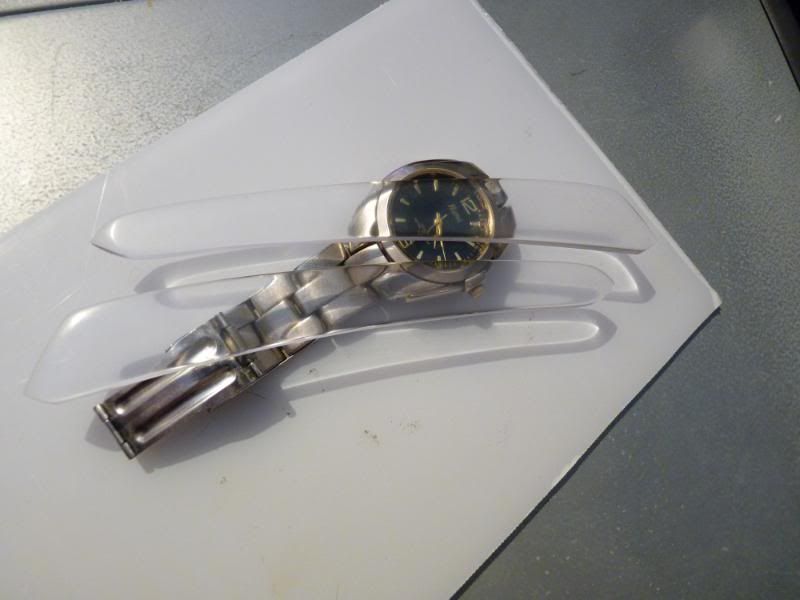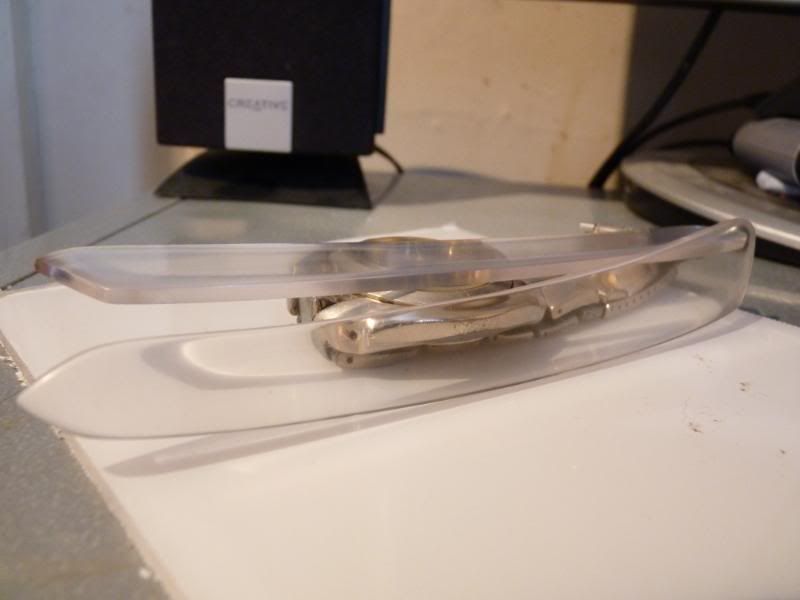Results 1 to 10 of 13
Thread: Clear Acrylic Scales
-
06-25-2011, 04:18 PM #1
 Clear Acrylic Scales
Clear Acrylic Scales



Well I've started them now so I'll finish, but I won't use it again!
Does anyone have any good tips for polishing acrylic?
What do you make of the shape also?
These are my first set, I plan to use them to replace some old leather scales on a 6/8 Sheffield blade.
Looking for inspiration for the wedge as well.
I kind of have some ideas floating around in my head about using polarising film at opposing angles to give some interesting patterns, possibly as a liner, or maybe only at the wedge.

Anyway, all comments, suggestions, critique etc welcomed - it all helps me learn
Cheers
P
-
06-25-2011, 04:20 PM #2I used Nakayamas for my house



- Join Date
- Aug 2009
- Location
- Des Moines
- Posts
- 8,664
- Blog Entries
- 1
Thanked: 2591
sandpaper 400-2000, then micromesh up to 12k , then some sort of plastic polisher or maas/flitz/mothers
You can also buff it but you need buffing compound for plastic and slow speeds.Stefan
-
The Following User Says Thank You to mainaman For This Useful Post:
PaddyX21 (06-25-2011)
-
06-25-2011, 04:29 PM #3

I'm going to have to find me a uk supplier for the micro-mesh I keep hearing about - time to hit Google me thinks!
Thanks for the advice
-
06-25-2011, 05:53 PM #4

jeweller's rouge will do a pretty good job of polishing plastic, but the slow speed is a good idea, and if you can't run your equipment as slow as you would like, very light pressure is indicated. It needn't be desperately slow. In the days when Black and Decker drills had a rather good mechanical gearbox, the slow speed of about 500rpm was fine.
You can do the calculations and find that the small polishing mops sold with Dremel tools give much the same peripheral speed as a larger, slower mop. But this is not the whole story. The Dremel mop or pad spends much less time out of contact with the workpiece, and therefore loses a lot less of the heat it gains. It is difficult to do good polishing of flat plastic with one of these.
I believe, though it doesn't apply with all plastics, that acrylic can be dyed with the dyes available for fabrics. They are available in a version intended to be simmered in water, or another that can be done in a washing machine. A slightly discoloured white shirt or two to do at the same time would make it worthwhile.Last edited by Caledonian; 06-25-2011 at 05:57 PM.
-
06-25-2011, 06:32 PM #5

I've used the dremmel buffing wheel on slow(ish!) with the indeterminate rouge they supply on these after 1200grit atm, but it's really more so I can see what my progress is and where I need to go back to with the 1200grit, or even 800grit in one case grrrr! In fact I had to go all the way back to 240grit at one point while learning how much heat the dremmel generates

The little things that you wouldn't see at all on a solid colour acrylic are painfully obvious on this crystal clear stuff, in fact I've considered leaving them with a satin finish for that translucent look, but I think I'll stick with it.
I'm a bit short on tools tbh, in fact one dremmel and two hands lol, but I think they are coming along nicely atm. They are probably down iro 3.5-4mm per side, and next time I'd definitely consider 3mm stock and leaving the protective film on, rather than sanding the whole lot back.
I have loads of the clear acrylic in 5mm stock (well it looks 5mm I haven't measured it!), so I may give that fabric dye a go. I wonder if it would keep the transparency, but take on the colour, or if it'll become slightly translucent
Cheers
P
-
06-25-2011, 06:37 PM #6

Well first, I've found it works on the British perspex as formulated many years ago. I believe US plexiglas is very similar, but it might be worth trying on scraps. I don't believe it sinks into the surface, so it would have to be done after polishing.
Another possibility which I'm sure would work, is to create a textured finish all over with the Dremel and a small ball burr, and then polish that.
-
06-25-2011, 06:48 PM #7
-
06-25-2011, 07:31 PM #8

I've had some ideas like these as well, but I've been thinking liners. Shell material is what's been on my mind, but I can't see no reason it could not be used with wood, metal film, fabric or even photographs. Possibly sandwitching it inbetween 2 layers of clear plastic, or maybe gluing it on to the back. Used like this, the clear acrylic would kinda work along the same lines as clear epoxy coatings, providing both protection and rigidity to the scales.
I'd be very interested to see pics if you decide to go through with it.
Best of luck.
-
06-25-2011, 10:15 PM #9

Plastic can be frosted with solvents. In the case of perspex ether is a solvent. But I think there are still drawing pens by Rotring and other makers which are of specially formulated, expensive plastic so as to resist an ink which etches into the plastic film used in the graphics art industry. The solvent is available separately for cleaning the pens, which consist of a tubular nozzle with a close-fitting rod inside. I believe this would attack most plastics in common use.
-
06-25-2011, 10:34 PM #10


 LinkBack URL
LinkBack URL About LinkBacks
About LinkBacks






 Reply With Quote
Reply With Quote


